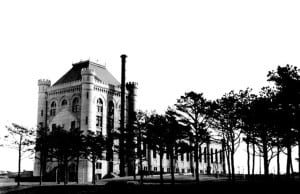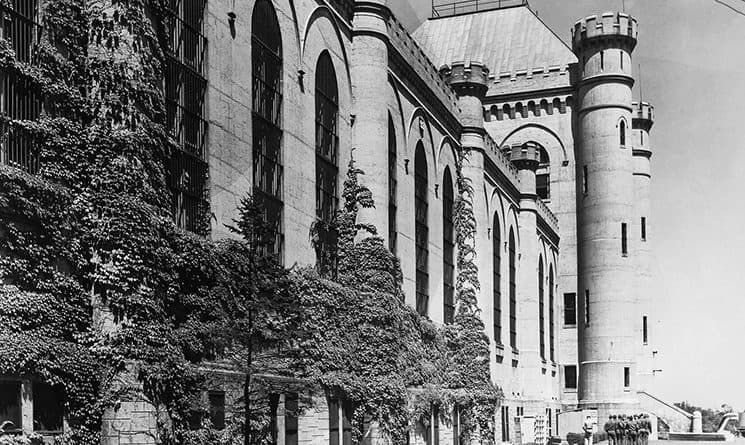Neil Novello explores the Portsmouth Naval Shipyard prison in “The Castle”
by Larry Clow
It’s been more than a century since the prison at the Portsmouth Naval Shipyard opened, and in the same way that the massive stone walls and turrets of the building, nicknamed “the Castle,” have loomed over the Piscataqua River, so too has the prison loomed in the imagination of Seacoast residents. The prison has inspired local legends and myths, but for Maine filmmaker Neil Novello, the true history of the prison is more thrilling than any legend.
“It creates its own mystery because … you can’t seem to approach it,” Novello said. “Stories build up, or are passed along.”
Novello produced two documentaries about the prison in 2008 — “The Castle,” and “TMO@The Castle,” which he’ll be sharing material from and discussing at the Rye Public Library on Wednesday, Feb. 11.
The prison opened in 1908 and remained in operation until 1974. It housed Navy sailors and Marines serving time for a variety of offenses; a captured German U-boat crew was also imprisoned there at the end of World War II. In those 66 years, the prison inspired myths — one tale claims that Walt Disney was an inmate and based the design of the castle in “Cinderella” on the prison — and achieved a slice of Hollywood fame in 1973’s “The Last Detail,” in which Jack Nicholson must escort Randy Quaid to the prison, although the prison never appeared in the movie.
“It creates its own mystery because … you can’t seem to approach it.” — filmmaker Neil Novello
Novello first encountered the prison in 1996. He’d moved up from Oxford, Miss., to Kittery, Maine, and set up a video production business with a former colleague. Their first project was a documentary following a dance company commissioned by The Music Hall to stage a performance celebrating the shipyard. Novello followed the dance company on a tour of the shipyard; the prison was one of the stops. That visit prompted Novello to track down a 1972 documentary produced by the Navy that offered a look inside the prison.
It was enough to capture Novello’s attention. “I wanted to know more about the history of the prison and more about the types of inmates who had gone through there,” he said.
Novello read books about the prison’s history and discovered other footage in the Navy’s archives. The prison’s evolution coincided with the evolution of penology — changes in how commanders ran the prison were reflected in attitudes toward rehabilitation and punishment in the civilian world.
“You’re seeing … the military start from scratch and build itself an institution,” he said.
Novello collected exterior footage of the prison while working on a documentary about the shipyard’s 200th anniversary in 2000. He wasn’t allowed to go inside the building; however, he said shipyard officials were accommodating when it came to setting up shots and gathering material for the film.
The Portsmouth Naval Shipyard prison in 1956
As part of his research, Novello interviewed prison guards and others who worked there. It was a process of referrals, he said — finding one person who’d give him the names of other former prison employees, who in turn would provide him with more names. It took him some six years to conduct the interviews and do research.
He even tracked down some former prisoners, though none would go on camera. Because Navy disciplinary records are sealed, Novello had to use other means to track down prisoners.
“I had copies of the prisoner-published newsletter, The Castle Courier, and I got that from several sources. Prisoners would publish articles (with a byline), like ‘So and so prisoner was seen with shop foreman,’” he said.
He found one former prisoner living in Hawaii, and another in Ohio. But both were reluctant to share their stories.
“The fellow in Ohio … was there in 1956. He spent about six months there,” Novello said. The man had grandchildren, and didn’t want them to find out, by way of the documentary, that he served time in the prison.
As he dove deeper into his research, Novello found more and more stories from the prison that he wanted to explore. That led to a second companion documentary, titled “TMO@The Castle,” about Thomas Mott Osborne, the prison’s only civilian commander. Osborne took charge of the prison in 1917 and introduced sweeping reforms — rather than simply punishing inmates, Osborne instituted training and rehabilitation programs. During his three-year tenure, he reduced the number of guards and let the prisoners govern themselves. Osborne also brought a film crew to the prison and produced a short documentary, which Novello was able to track down.
“When I saw all of this … great material about (Osborne), I thought there was a documentary in and of itself, about how his life got him to the prison and his impact on the prison,” Novello said.
Novello believes interest in the prison has endured because it remains just out of reach. Looking at the turrets and stone walls from the Portsmouth waterfront is about as close as one can get to the prison. The Navy announced in 2014 it was again seeking developers interested in renovating and re-using the prison, but so far, no plans have been announced. The Castle may yet have a second life; for now, though, Novello’s film is a fitting biography for its first life.
Neil Novello will present “The Castle” on Wednesday, Feb. 11 at 7 p.m. at the Rye Public Library, 581 Washington Road, Rye. Snow date is Feb. 18. Call 603-964-8401 or visit ryepubliclibrary.org.


